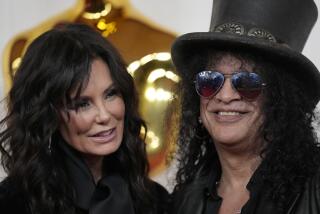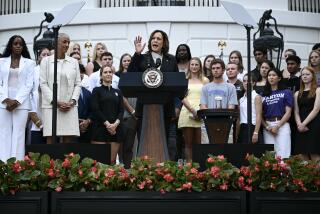Call Him an Alchemist of the Everyday
For the last month, Robert Therrien’s downtown sculpture studio could have doubled as a costume shop for giants. For one thing, a 15-foot-tall beard made of stainless steel “hair” is hanging by its earpieces from a metal stand.
“I thought the beard was an interesting subject because it’s a symbol of the artist,” Therrien says, by way of explanation. “At one point, one of the models was Brancusi’s beard, but I eliminated it because it was the wrong shape. Now it’s closer to Rodin’s beard--but didn’t all great artists have beards?”
The beard of steel joins more beards, made of plaster and of plastic, along with 30 other pieces created since 1992, in the show “Robert Therrien” at the Los Angeles County Museum of Art.
Beards are not the only idiosyncratic elements in an exhibition that includes 15 beds coiled into a spiral, thick blue plates stacked to a height of 8 feet, and a massive Dutch door opening into a blank wall. There are also a table and chairs tall enough for adults to stand under without stooping.
LACMA’s curator of modern and contemporary art, Lynn Zelevansky, organized the show. “Bob is from a generation in which Conceptualism has had an enormous impact. There are concepts in the work, yet it remains dominantly visual. It’s about your body and your perception in relation to these objects, which will work on you physically. When you stand next to them, they can change the way you see the world.”
*
Not surprisingly, Therrien sees the world from a great height. At 53, he stands more than 6 feet tall. Reticent, he values his privacy (he doesn’t even own a phone answering machine).
Therrien is nothing if not precise. Smoking one cigarette after another, and wearing a habitual hangdog expression, he trains his blue eyes appraisingly on the curves and patinas of the beards in his studio. Since much of his sculptures’ impact is based on enlarged scale and verisimilitude, the execution must be exact.
The artist tugs at the soft wire curls of the stainless-steel beard and describes his early frustration when attempting to make it and the others look just right. “I didn’t know much about it,” he says, “so they looked flat.” Then, he got advice from a wig maker. Now the beards have the luxuriantly tousled effect of any self-respecting Santa Claus.
Walking upstairs to the loft where he lives alone, Therrien points out a large table covered with scrub brushes of all sizes and shapes. Some are just large enough to defy the possibility of functional employment. These were made by Therrien as sculptures to be shown with smaller mass-produced scrub brushes--a floor brush with pink nylon bristles, a suede brush with tiny white ones. All have smooth wooden handles that appealed to the artist.
“I don’t know how to present them,” Therrien says, worrying. “If I put them together as a group, they read as a family. I don’t know if I want that. Maybe I’ll line them in rows.” (In the end, only a photograph of one of his brushes is included in the show.)
Objects, in Therrien’s world, take on a life of their own. The quotidian is transformed. Pieces like the scrub brushes often look as though they were imported from “Fantasia,” and even Therrien makes the connection.
“I have an attraction to the animated aspect of a cartoon, that really factors into the work,” he says. “I think cartoons are part of a lot of people’s consciousness. Cartoons have really reductive body parts. They are reduced to the simplest forms. I end up with images like that.”
In the studio, Therrien opens a storage-room door and offers a visitor a view of his collection of magic props and disguises. It is full of rubber noses and plastic ice cubes, parts of toy animals and packaged cotton candy, rubber dolls, fake flowers and an old circus organ. They act as insouciant sources of inspiration.
In fact, comic books were Therrien’s earliest introduction to art, just as they were for many artists of his generation. “I drew from comic books,” he says, “and thought that I had a style of sorts.”
A Chicago native, Therrien moved at age 9 with his family to Palo Alto. “I always remember thinking that I was some sort of artist, then becoming obsessive about it as a teenager,” he recalls. He attended California College of Arts and Crafts in Oakland from 1968 to 1969 and took a few classes at UC Berkeley. Then he decided to pursue photography and transferred to Santa Barbara’s Brooks Institute. Once enrolled, he found that he was less interested in making fine photographs than in drawing and making sculpture.
“I fell into the art studio thing there, so I’d go back and forth between making objects and taking pictures,” he says.
After he graduated with a bachelor’s degree in fine art, Therrien went on to graduate school at USC. After earning his master’s degree, in 1974 he leased a studio for $150 a month on Pico Boulevard and began to hone the evocative wall reliefs and modestly sized sculptures of subjects like snowmen and keyholes that first attracted critical attention and exhibitions.
“Mostly I stayed in my studio and had a completely normal, quiet work schedule and occasionally sold something to some curious person, enough to keep me going. I was sort of undisturbed during those 10 years. I think it formed a strong work pattern that I still have: always working at least eight hours, mostly at night.”
He labored in relative obscurity until 1985, when he was included in the Whitney Biennial and taken on by the late, legendary New York art dealer Leo Castelli. (He is now represented by the Larry Gagosian Gallery.)
The following year, his work was featured in the opening exhibition of the brand-new L.A. Museum of Contemporary Art, which bumped his career officially into the big time.
When, in 1991, he was given a survey exhibition by the Reina Sofia Museum in Madrid, curator Margit Rowell described the work as “both deja vu and jamais vu.” She referred to his scale as “confidential,” which nicely described Therrien’s work up to that time--poetically reductive sculptures and paintings of simple but evocative shapes such as the snowmen and keyholes. Minimalism and Constantin Brancusi were cited as influences.
Around that time Therrien said of his work, “What I do doesn’t translate into a large scale.” Artists, however, often contradict themselves. The year after the Madrid show, at Angles Gallery in Santa Monica, Therrien built an installation of bright red benches the size of church pews raked around a small stage.
“That could be considered the first large-scale work,” he says.
Shortly after that, Therrien took a series of photographs of staged tableaux to illustrate “The Dream Hospital,” a book of poetry by art critic John Yau. Some of those photographs inspired the sculpture in the current exhibition. Therrien explains, “His [verbal] imagery pushed the work into the domestic realm a little, with beds and plates.”
Equally important, the return to photography inspired him to work closer to reality and on a monumental scale. “I started using photography as a tool for figuring out ideas,” he says. “As a result, the pieces are more recognizable as real objects than before.”
He brings out a box of Polaroids taken of the view from beneath his actual kitchen table, which led to the 10-foot-tall table in the show. “The details are in being underneath and looking up so you could see the fastening by brackets,” he says. “I always thought of it as being experienced as an interior with a complexity of horizontals and verticals and diagonals, so that it would be like being in a jungle of legs.”
The bigger scale meant Therrien had to work with the fabricators at La Paloma, a Sun Valley factory known for its work with artists. Therrien, whose earlier works had an intimate, hand-finished appearance, says that the La Paloma staff helps him maintain a personal touch. “If I need to shorten something by 10 feet, they do it. If it’s not enough, they’ll shorten it more. On a large-scale sculpture, [those refinements] are a way to have immediacy. It helps me take the work a little bit further.”
Critics have discerned similarities between Therrien’s work and the sculpture of Claes Oldenburg, who is known for his inflated re-creations of everyday objects, and with the industrial forms of Richard Serra. Critic Gregory Salzman observed in Parachute magazine that Therrien seeks to “bridge the ideological differences between Pop and Minimalism. . . . [His art] has more to do with the commonality of domestic space than with the alienated world of the commodity. . . . Through its quiet self-assurance that admits vulnerability and idiosyncrasy, it disarms the . . . polarizations of belief that pervade the art and politics of our times and culture.”
*
From obvious cartoon echoes to arcane critical responses, references to childhood are unavoidable when it comes to Therrien’s monumental art.
Asked if his own memories of growing up play a part in the genesis of his art, Therrien says, “I remember more specifically having an empathy or sympathy for objects, for instance, the scrub brushes. I feel some connection. In literature or poetry, it’s called ‘sympathetic fallacy.’ In psychology, it’s called ‘projected identification.’ In anthropology, it’s called ‘participation mystique.’ ”
He has written all three phrases on a piece of paper tacked to his kitchen wall amid drawings of his own work, photographs of other objects and people, news clippings, oddments.
He comes back to the beards. They are his most recent sculptures, and he is clearly excited about them.
“I wanted to make something figurative that I could approach in different materials,” he says. “For some reason, I wanted them to be fake beards. The type of beard in a cartoon image. A beard from animation can have a life of its own, can start walking around. I don’t know if it is a search for that, but I end up with images like that.”
In the process, he may have stumbled upon a new genre in art history.
LACMA curator Zelevansky laughs at the suggestion, then admits, “It might be the first Western beard sculpture. I can’t think of any other sculpture of beard without face attached to it.”
*
* Robert Therrien, through May 7, Los Angeles County Museum of Art. 5905 Wilshire Blvd. Mondays, Tuesdays, Thursdays, noon-8 p.m.; Fridays, noon-9 p.m.; Saturdays and Sundays, 11 a.m.-8 p.m.; closed Wednesdays. $1-$7; children under 5, free. (323) 857-6000.
More to Read
The biggest entertainment stories
Get our big stories about Hollywood, film, television, music, arts, culture and more right in your inbox as soon as they publish.
You may occasionally receive promotional content from the Los Angeles Times.






